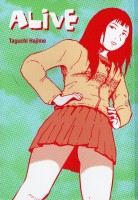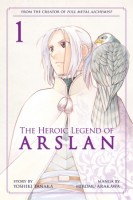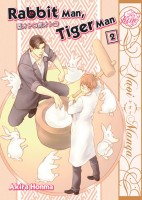My News and Reviews
There were three posts of note at Experiments in Manga last week in addition to the usual My Week in Manga feature. First of all, the winner of the Nana manga giveaway has been announced. The post also includes a short list of manga that people gave a second chance only to discover that they enjoyed them better than they did the first time they read them. I also posted August’s Bookshelf Overload, revealing how out of hand things can get when it comes to the number of manga I obtain over the course of a month. The first in-depth manga review of the month was also posted, the honor going to Hinoki Kino’s No. 6, Volume 8, the series penultimate volume. As a bonus, the first print run of the volume also includes sixteen color pages!
A few things of note from elsewhere online: The Beautiful World, which hosted the Kaori Yuki Manga Moveable Feast a while back, has issued a call for participation for a blog carnival to feature female goth mangaka in January. Sean has a nice roundup of some of the recent license announcements at A Case Suitable for Treatment. And Anna at Manga Report checks out Sparkler Monthly, which is currently running a membership drive for its second year. Please consider subscribing if you can; Sparkler Monthly has some great content and I hope for its continued success.
Quick Takes
 Alive by Hajime Taguchi. Gen Manga publishes independent manga, mostly focusing on the seinen demographic. Often, Gen’s releases are the first time the creator’s doujinshi have received any sort of “official” publication. Alive is a collection of over a dozen short manga of varying lengths by Hajime Taguchi. There’s not really a central theme to the volume, and the stories aren’t related to each other, but they all tend to be fairly melancholy. A few of the tales have some fantastical or surreal elements to them—a pair of glasses that obscures everything the wearer dislikes, a bizarre frog-like creature that talks, and so on—but most of the manga in the collection tend to be realistic, slice-of-life stories. Alive primarily explores the emotional lives of the stories’ characters. Love, heartbreak, self-confidence, guilt, personal growth, and loss are all present within the manga. Generally Alive focuses on the darker aspects of the human psyche and experience, but there are glimpses happiness as well. As with any collection, some stories are stronger than others, but as a whole Alive is a satisfying and somewhat unusual read.
Alive by Hajime Taguchi. Gen Manga publishes independent manga, mostly focusing on the seinen demographic. Often, Gen’s releases are the first time the creator’s doujinshi have received any sort of “official” publication. Alive is a collection of over a dozen short manga of varying lengths by Hajime Taguchi. There’s not really a central theme to the volume, and the stories aren’t related to each other, but they all tend to be fairly melancholy. A few of the tales have some fantastical or surreal elements to them—a pair of glasses that obscures everything the wearer dislikes, a bizarre frog-like creature that talks, and so on—but most of the manga in the collection tend to be realistic, slice-of-life stories. Alive primarily explores the emotional lives of the stories’ characters. Love, heartbreak, self-confidence, guilt, personal growth, and loss are all present within the manga. Generally Alive focuses on the darker aspects of the human psyche and experience, but there are glimpses happiness as well. As with any collection, some stories are stronger than others, but as a whole Alive is a satisfying and somewhat unusual read.
 The Heroic Legend of Arslan, Volume 1 by Hiromu Arakawa. Based on a series of fantasy novels by Yoshiki Tanaka, Arakawa’s The Heroic Legend of Arslan is one of several adaptations that have been made. Although the animated film had previously been released in English, Arakawa’s manga was actually my introduction to The Heroic Legend of Arslan. The first volume feels a bit like a prologue, introducing the characters and setting the stage for the story which will be the series’ real focus. Arslan is the young prince of Pars, mostly ignored by his parents but hoping to be seen as worthy by them. His chance to prove himself comes when the kingdom of Lusitania invades Pars, bringing war and destruction with it. In the first volume alone there have already been several battles and betrayals. Blood and death will not be strangers to Arslan, though it seems he would much prefer to find peaceful solutions to the fighting. So far, I’m enjoying The Heroic Legend of Arslan. It’s shaping up to be a solid fantasy series and the setting, which is influenced by historical Persia, is particularly interesting. I certainly look forward to reading more of the series to see how it develops.
The Heroic Legend of Arslan, Volume 1 by Hiromu Arakawa. Based on a series of fantasy novels by Yoshiki Tanaka, Arakawa’s The Heroic Legend of Arslan is one of several adaptations that have been made. Although the animated film had previously been released in English, Arakawa’s manga was actually my introduction to The Heroic Legend of Arslan. The first volume feels a bit like a prologue, introducing the characters and setting the stage for the story which will be the series’ real focus. Arslan is the young prince of Pars, mostly ignored by his parents but hoping to be seen as worthy by them. His chance to prove himself comes when the kingdom of Lusitania invades Pars, bringing war and destruction with it. In the first volume alone there have already been several battles and betrayals. Blood and death will not be strangers to Arslan, though it seems he would much prefer to find peaceful solutions to the fighting. So far, I’m enjoying The Heroic Legend of Arslan. It’s shaping up to be a solid fantasy series and the setting, which is influenced by historical Persia, is particularly interesting. I certainly look forward to reading more of the series to see how it develops.
 Kokoro Connect, Volume 1 written by Anda Sadanatsu, illustrated by CUTEG. I tend to enjoy series that involve body-swapping of some sort (it often provides clever opportunities for the exploration of personal identity), so I was curious about the Kokoro Connect manga, especially after hearing good things about the anime. In most of the body-swapping series that I’ve been exposed to generally only two people are involved, usually of the opposite gender. Kokoro Connect, however, involves five high school students—two boys and three girls—who one day begin to spontaneously switch places in all sorts of different combinations. This means that there are plenty of comedic possibilities for the series, but for the most part Kokoro Connect seems to be taking a more serious approach, addressing some of the more sobering implications of involuntarily swapping places with another person. The group does seem to be handling the whole situation remarkably well so far, though. There is a half-hearted attempt to begin to explain the whole swapping phenomenon, but it’s not especially compelling at this point.
Kokoro Connect, Volume 1 written by Anda Sadanatsu, illustrated by CUTEG. I tend to enjoy series that involve body-swapping of some sort (it often provides clever opportunities for the exploration of personal identity), so I was curious about the Kokoro Connect manga, especially after hearing good things about the anime. In most of the body-swapping series that I’ve been exposed to generally only two people are involved, usually of the opposite gender. Kokoro Connect, however, involves five high school students—two boys and three girls—who one day begin to spontaneously switch places in all sorts of different combinations. This means that there are plenty of comedic possibilities for the series, but for the most part Kokoro Connect seems to be taking a more serious approach, addressing some of the more sobering implications of involuntarily swapping places with another person. The group does seem to be handling the whole situation remarkably well so far, though. There is a half-hearted attempt to begin to explain the whole swapping phenomenon, but it’s not especially compelling at this point.
 Rabbit Man, Tiger Man, Volume 2 by Akira Honma. It might not be the most believable boys’ love series out there, but I was amused by and rather enjoyed the first volume of Rabbit Man, Tiger Man. While there is still plenty of humor in the second volume of the series, the manga has really started to take a turn for the serious. The yakuza plotline has become more prominent, introducing a significant amount of danger to the story. However, the delightful awkwardness between the series’ two leads still remains. Nonami and Uzuki are complete opposites in personality and demeanor. (They would be the titular tiger and rabbit.) It’s actually rather funny and sweet to see how hard the rough, tough yakuza boss has fallen for the meek, diminutive surgeon. I do think that I probably enjoyed the first volume of Rabbit Man, Tiger Man slightly more than the second, but I definitely want to read the third and final volume. Sadly, there’s no indication that it has or will be licensed. This is particularly frustrating since the second volume ends on one heck of a cliffhanger.
Rabbit Man, Tiger Man, Volume 2 by Akira Honma. It might not be the most believable boys’ love series out there, but I was amused by and rather enjoyed the first volume of Rabbit Man, Tiger Man. While there is still plenty of humor in the second volume of the series, the manga has really started to take a turn for the serious. The yakuza plotline has become more prominent, introducing a significant amount of danger to the story. However, the delightful awkwardness between the series’ two leads still remains. Nonami and Uzuki are complete opposites in personality and demeanor. (They would be the titular tiger and rabbit.) It’s actually rather funny and sweet to see how hard the rough, tough yakuza boss has fallen for the meek, diminutive surgeon. I do think that I probably enjoyed the first volume of Rabbit Man, Tiger Man slightly more than the second, but I definitely want to read the third and final volume. Sadly, there’s no indication that it has or will be licensed. This is particularly frustrating since the second volume ends on one heck of a cliffhanger.
